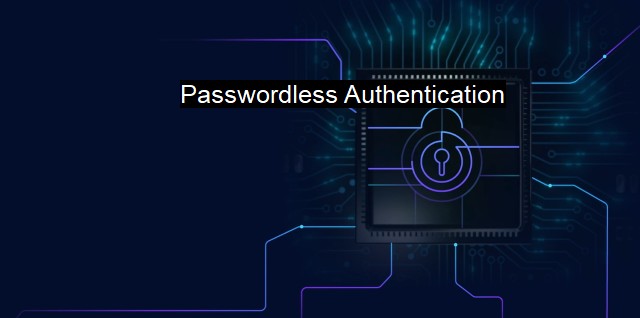What is Passwordless Authentication?
Revolutionizing Cybersecurity: The Benefits of Passwordless Authentication
Passwordless Authentication is a modern way of verifying the identity of users in a system without the necessity for remembering complex combinations of letters, numbers, and other special characters. This form of authentication ranges from biometrics to magic links, and it has been embraced wildly in the world of cybersecurity and antivirus software development for a variety of reasons which are centered on improving user experience and enhancing system security.At first glance, the term "Passwordless Authentication" can seem like an ironic contradiction, if we recall that authentication, since the dawn of the internet age, has largely been facilitated by the use of passwords. the advent of this form of verification is the resultant effect of the innovation in the identity access management landscape. Driven by the demand for a more streamlined, swift, yet secure way of confirming users' identities, passwordless authentication foregoes classical passwords and substitutes them with more trustworthy, more user-friendly authentication systems.
Passwords have long been the default guard against unauthorized access to resources, applications, and data. they have their limitations. They are renowned for their susceptibility to theft, forgetting, guess-work, and brute force attacks, which compromise overall system security. users often reuse their passwords through multiple platforms because they are hard to remember, facilitating credential stuffing attacks. This has caused burdens to both the users, who must strive to remember a myriad of them, and system administrators who must deal with an infinitely continuous chain of password resets. Passwordless authentication, though, sidesteps these problems.
Deploying the methodology of passwordless authentication comes in various forms. One widely used fashion is the utilization of biometrics, such as fingerprint recognition or facial recognition. Most modern smartphones adopt biometric authentication in the form of Face ID or Touch ID, making it a familiar method to most users, and arguably one of the easiest passwords to remember – after all, you always have your face and fingerprints with you.
Another popular method is the release of temporary one-time codes sent to the user's email address or mobile phone, which are then used to validate their identity. This method, often found as two-factor authentication, adds an additional layer of security where even if the email or the device is compromised, the code is useless after one-time utilization.
Passwordless authentication has also been made possible by the use of authentication apps or security keys that create a secure channel of communication between the user and the server without the need for a password. This method, known as token-based authentication, stores information required for user verification, which allows providers to confirm that the user is who they say they are and ensure safe authorization.
Passwordless authentication has been adopted in the cybersecurity and antivirus sectors because of its numerous benefits. It enhances security measures, reduces the cost associated with password resets, improves the system or application's safety, and simplifies the user experience.
While these features appear promising, this form of authentication isn't without potential downfalls. Many passwordless systems, most notably biometrics, introduce new privacy concerns and can be vulnerable to sophisticated physical attacks that replicate biometric characteristics using fake fingerprints, photographs or voice recordings. This means that just as with historic passwords, great care needs to be given to the risks associated with passwordless systems.
a world without passwords is no longer a mere aspiration but a feasible reality in our digital age. Passwordless authentication brings forth both more secure and user-friendly exposure while uncovering new challenges in the practice of secure user verification and identity access management. The move away from passwords showcases progress in cybersecurity but requires continuous development and refinement to ensure every potential risk is addressed.

Passwordless Authentication FAQs
What is passwordless authentication?
Passwordless authentication is a type of authentication that eliminates the need for passwords to access an application or system. Instead, it relies on other factors such as biometrics, one-time codes or hardware tokens to verify the user's identity.How does passwordless authentication improve cybersecurity?
Passwordless authentication reduces the risk of cyberattacks that target passwords, such as phishing, credential stuffing and brute force attacks. Since there are no passwords to steal or guess, hackers have a harder time infiltrating systems and stealing sensitive data.What are some examples of passwordless authentication methods?
Some examples of passwordless authentication methods include fingerprint recognition, facial recognition, hardware tokens, SMS or email verification codes, and push notifications.Is passwordless authentication more secure than traditional password-based authentication methods?
Yes, passwordless authentication is generally considered more secure than traditional password-based authentication methods. Since passwords are often weak or reused across multiple accounts, passwordless authentication eliminates the risk of password-related vulnerabilities. However, it is important to note that no authentication method is completely foolproof, and additional security measures should always be in place to protect against cyber threats.| | A | | | B | | | C | | | D | | | E | | | F | | | G | | | H | | | I | | | J | | | K | | | L | | | M | |
| | N | | | O | | | P | | | Q | | | R | | | S | | | T | | | U | | | V | | | W | | | X | | | Y | | | Z | |
| | 1 | | | 2 | | | 3 | | | 4 | | | 7 | | | 8 | | |||||||